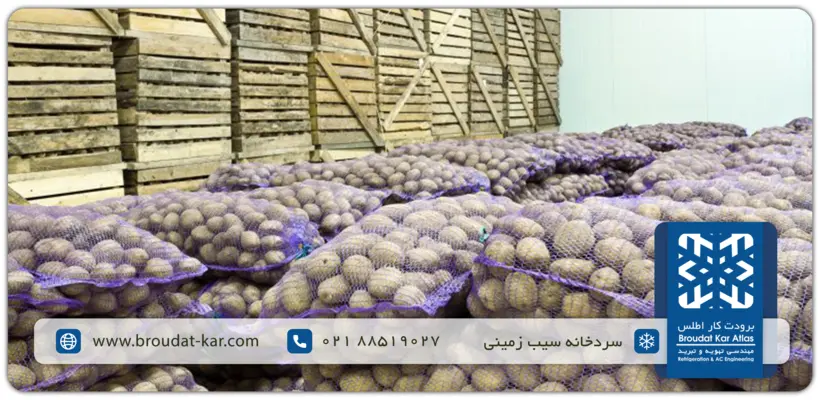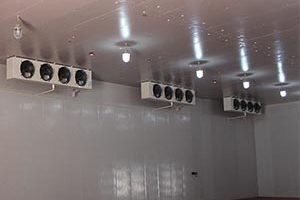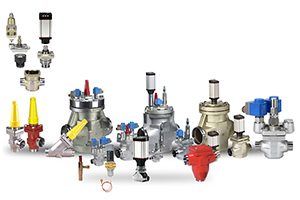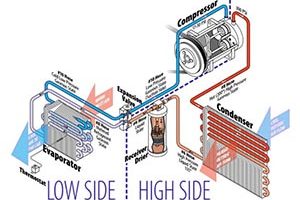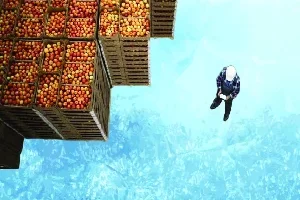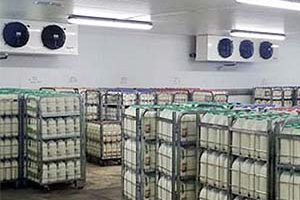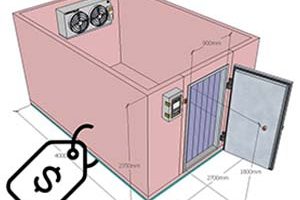Potato Cold Storage
Potatoes are among the most widely consumed and commercially important vegetables, and they can be stored for long periods under proper cold storage conditions. According to a 2021 report by the Food and Agriculture Organization (FAO), more than 370 million tons of potatoes were harvested worldwide — with Iran accounting for over 5 million tons of that total.
However, due to improper and unscientific storage methods, nearly 20% of the harvested potatoes are lost to spoilage. Fortunately, this issue is being addressed in many countries — particularly in Iran — through the use of potato cold storage facilities.

By maintaining standard storage conditions, a properly designed potato cold storage system can significantly reduce waste and extend the storage life of potatoes for up to 10 months without compromising quality.
Why Can Cold Storage Double the Shelf Life of Potatoes?
If you want to store harvested potatoes for a long period and sell them in later seasons, the best solution is to keep them in a properly designed potato cold storage facility.
In a potato cold room, temperature, light, and humidity levels are carefully controlled. Under these stable conditions, potatoes can be stored for several months without any changes in color, flavor, or texture, and without the risk of frost damage or sprouting.
This controlled environment effectively doubles the shelf life of potatoes while maintaining their market quality and freshness.
Benefits of Storing Potatoes in Cold Storage
The main advantages of using a potato cold storage facility include:
- Prevention of Frost Damage:
Potatoes are sensitive to extremely low temperatures. When stored below 4°C, they can suffer from frost injury. Maintaining a controlled temperature between 4°C and 12°C prevents freezing damage and helps preserve overall quality. - Prevention of Sprouting:
Factors such as high temperature and direct light exposure trigger sprouting in potatoes. In cold storage, maintaining a low temperature (4–8°C) and a dark environment inhibits the activation of growth hormones, effectively delaying sprouting. - Prevention of Excessive Weight Loss:
Potatoes gradually lose weight due to moisture loss through evaporation and transpiration, which reduces both their visual quality and economic value. By keeping the relative humidity between 90% and 95%, cold storage prevents excessive dehydration and helps maintain product weight. - Preservation of Color and Flavor:
When stored in poor conditions with low humidity or insufficient oxygen, potatoes may discolor and lose their natural taste. A well-designed cold storage system maintains optimal environmental conditions to preserve both appearance and flavor. - Improved Quality and Extended Shelf Life:
Maintaining the correct storage temperature and humidity levels significantly extends the shelf life of potatoes — allowing them to be stored for up to 10 months without any loss in quality.
Standard Conditions for Storing Potatoes in Cold Storage
The temperature and humidity levels required for potato storage depend on several factors, the most important being the type and maturity of the potatoes. Before placing potatoes in cold storage, it is necessary to determine whether they are sweet, immature, or fully matured, as each type requires specific storage conditions.
To prevent common issues such as sprouting, it is also important to follow proper storage practices. For instance, chemical sprout inhibitors such as CIPC (Chlorpropham) can be used in the cold room to control sprouting during long-term storage.
Another key aspect of proper potato storage is the gradual cooling process. Unlike many other agricultural products, potatoes should be cooled slowly over a period of two to three weeks. During this period, the potatoes should be exposed to air for about 6 to 7 hours per day, with the temperature gradually reduced by 1 to 2°C per day until it reaches the target storage temperature.
This gradual cooling method helps maintain the potatoes’ internal quality, prevents condensation, and minimizes stress or damage to the tubers.
| Storage Duration | Relative Humidity (%) | Cold Storage Temperature (°C) | Cold Storage Temperature (°C) | Type of Potato |
| 4–7 months | 85-90 | 12.7–16.1 | 21°C for 4–5 days | sweet potato |
| Up to 2 months | 90-95 | 4.4–10 | 21°C for 4–5 days | Immature Potato |
| 5–8 months | 95-98 | 4.4–12.2 | 10–15°C for 10–14 days | Mature Potato |
| 1–3 weeks | 95 | 8–10 | __ | Semi-Processed (Cut/French Fry) Potato |
Cold Storage for Export-Grade Potatoes
If you plan to export potatoes, it is important to maintain proper storage and transport conditions. During transportation, potatoes should be kept at a temperature between 4.4°C and 15°C, depending on factors such as shipping duration, packaging method, and humidity levels.
To achieve these optimal conditions, the cargo ship or aircraft must be equipped with a refrigerated compartment designed for potatoes — featuring 5 cm of insulation and an advanced air-conditioning and ventilation system.
The ideal temperature for export-oriented potato cold storage is around 7°C, with a relative humidity of 90–95%.
For long-distance or extended transportation, it is recommended to maintain a slightly higher temperature range of 12.7°C to 18.3°C to prevent chilling injury and preserve product quality during shipment.
How to Prepare Potatoes for Cold Storage
Before placing potatoes in cold storage, certain preconditioning steps must be followed. Skipping these steps can lead to rapid spoilage and significant financial loss. Below is a step-by-step overview of the proper process for preparing potatoes for cold storage.
Drying
The first step in the storage process is drying the potatoes. However, drying does not mean removing internal moisture. The goal is to eliminate surface moisture and any dirt or residue attached to the skin. This step prevents the growth of bacteria and fungi during storage.
For effective drying, potatoes should be kept at a temperature of around 25°C and relative humidity of 85% until the surface is completely dry.
Curing (Healing Process)
After drying, minor mechanical damages caused during harvesting or handling must be healed. To achieve this, potatoes are kept for 7–10 days at a temperature of about 15°C and relative humidity of 95%.
During this period, the potato’s outer tissue gradually repairs scratches and small wounds. This process greatly contributes to prolonging the storage life and maintaining the overall quality of the potatoes.
Cooling
Finally, the potatoes undergo a cooling phase before entering long-term storage. In this step, the air temperature in the cold room is gradually reduced to cool the potatoes evenly over several days.
The cooling rate should not exceed 1–2°C per day. Rapid temperature changes can damage the tubers and cause condensation.
Since maintaining and ventilating cold air can be costly, proper insulation and organized stacking of the potatoes are essential to minimize unwanted air exchange and ensure energy efficiency during this stage.
Potato Cold Storage Design
For designing a potato cold storage facility, several key factors must be considered, including the type of insulation, refrigeration and heating systems, ventilation and air circulation, and the quality of doors, among others. To fully optimize storage conditions, use appropriate equipment such as a high-quality evaporator for removing heat from the room and a condenser for rejecting that heat. Together with the compressor, these two components complete the refrigeration cycle. Be sure to size all equipment according to the required capacity.
For insulation, it is recommended to use high-quality sandwich panels with the following characteristics:
- The core should preferably be polyurethane (PU) foam.
- The outer cladding is typically galvanized steel or aluminum sheets.
When selecting the cold room door, consider the expected traffic level. If space is limited and you want to minimize energy loss, sliding doors are a better option. However, if there is heavy traffic and enough clearance for door swing, you can use hinged doors.
In addition to all of the above, do not underestimate the importance of air circulation and HVAC. A properly designed air movement system not only helps maintain stable room temperature, it also improves condenser performance and the overall efficiency of the refrigeration cycle.
Common Problems in Potato Cold Storage
During the operation and maintenance of a potato cold storage facility, you may encounter certain issues. There’s no need to worry—some of these problems can be resolved easily, while others may require assistance from professional technicians. Below are a few of the most common problems and their solutions.
Freezing of Products
One common reason potatoes freeze in storage is direct contact with the cold room walls. It may also result from poor air circulation or malfunctioning fans. Incorrect thermostat settings can also cause overcooling.
Solution: Adjust the thermostat to the correct temperature and ensure it is positioned properly. Avoid placing potatoes directly in the path of cold airflow, and always maintain sufficient spacing between the potatoes and the cold room walls.
Excessive Drying of Potatoes
If potatoes become dry and shriveled quickly, it is often due to low relative humidity inside the cold room or a large vapor pressure difference between the potatoes and surrounding air.
Solution: Clean the evaporator coils regularly to ensure efficient heat exchange, and replace faulty fans if necessary. Also, reduce the temperature of freshly harvested potatoes gradually to minimize vapor pressure differences between the product and the air.
Blackening of Potatoes
If your stored potatoes are turning black, it’s usually due to temperature fluctuations inside the cold room — frequent rises and drops in temperature cause internal stress in the tubers.
Solution: Maintain a stable and consistent temperature within the standard range. Also, check the humidity level — low humidity can contribute to discoloration. Keep the relative humidity between 90% and 95% to preserve the potatoes’ natural color and freshness.
Conclusion
In conclusion, when a potato cold storage facility is properly designed, installed, and operated, it not only prevents product loss but also leads to significant cost savings. However, poor construction or incorrect operation can result in serious issues such as sprouting, blackening, or spoilage of potatoes.
Therefore, if you are planning to purchase or build a potato cold storage facility, it is strongly recommended to work with experienced professionals who specialize in the design and installation of refrigeration systems.
One of the most reputable companies in this field in Iran is Atlas Refrigeration Co. Ltd., which has extensive experience in manufacturing and supplying cold storage equipment, as well as in the installation and commissioning of various types of cold rooms.
To reduce power consumption, make sure the ceiling and walls are properly insulated and check for any air leaks in the insulation. Additionally, using polyurethane (PU) panels with a density of 40 kg/m³ and appropriate thermal resistance for each temperature zone is highly recommended.
In short, if your storage capacity is below 2,500 tons, Freon (R-series refrigerants) is a better option. For larger facilities exceeding 2,500 tons, ammonia (NH₃) is more efficient and cost-effective.
To minimize weight loss, maintain relative humidity between 85% and 95%. Ensure proper air circulation and ventilation to prevent moisture loss and condensation (sweating) on the potatoes.
Related posts
Potato Cold Storage
Valves and Control Devices in Ammonia and Freon Refrigeration Systems The variety of valves and control devices in refrigeration systems
Cold Storage Equipment Cold storage equipment encompasses a variety of machines and devices specifically designed to store perishable goods at
What is Fruit Cold Storage? A Fruit cold storage is a specialized facility designed to store fruits and vegetables
What is Industrial Cold store? An industrial cold store is a large-scale facility designed and constructed to preserve and
Cold Room Price Estimation – Year 2024 At Atlas Refrigeration, we recognize the pivotal role cold rooms play in diverse
